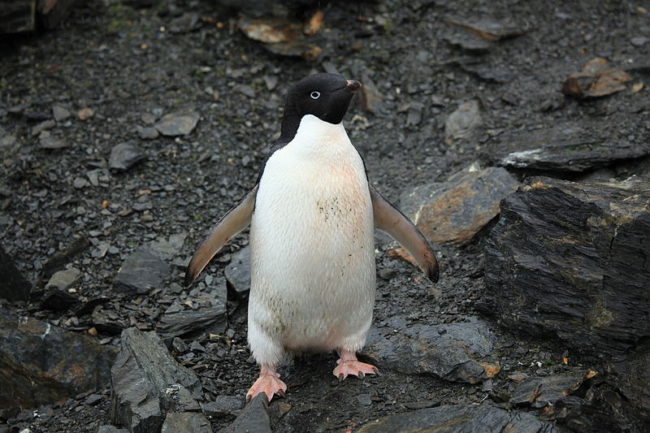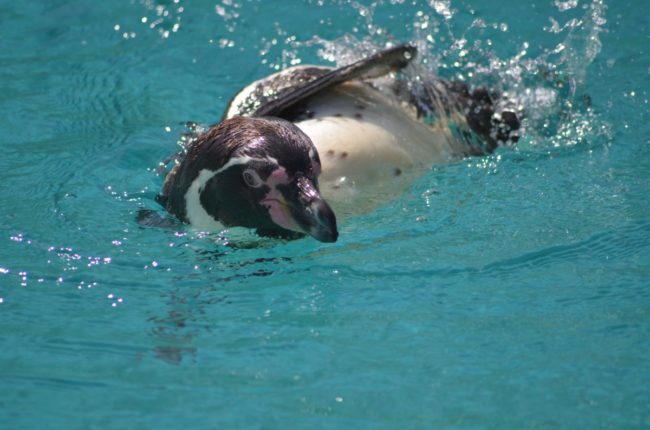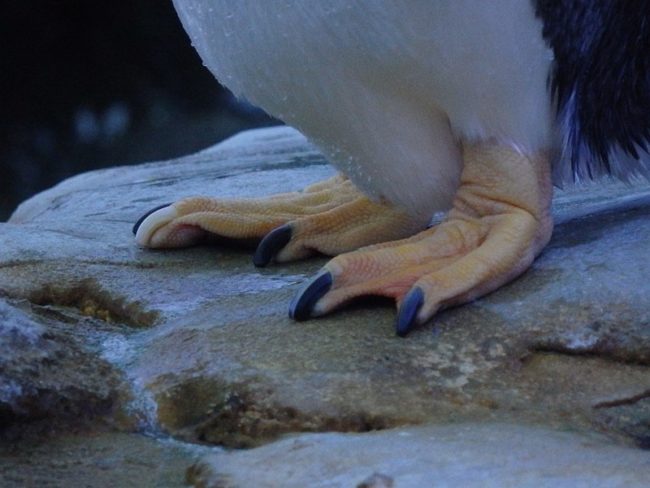The mysterious landmass of Antarctica is, no doubt, the coldest place on earth. The highest temperature ever documented in the south was a staggering -12.3 degrees Celsius (temperatures near the core have been predicted as low as -40 degrees Celsius).
Yet, this icy continent is home to over 20 species of birds and mammals, including seals, whales, and penguins, each of which found a way to cope with the extreme cold.
The seals can rest entirely on one side of their body due to the cold ground’s insulating body fat called blubber.

Penguins body with flippers and legs
However, birds often fly to warmer resting regions. The Penguin, however, could be considered unlucky in this aspect, as they must spend much of their lives standing on the ice.
To put into perspective, if we happened to stand barefoot on ice, our feet would dangerously become pale and numb within an hour. We could get painfully frostbitten – severe enough to lose our limbs.
What do we usually do when we step on a cold floor or water? Our first instinct is to lift our toe slightly above and use our heel to stand, maybe even walk a couple of steps since the heels are much more capable of tolerating cold than our toes.
The penguins also do a similar trick, but they need to depend on their tails to balance extended rest periods.
For instance - the plight of the emperor penguins
The idea of ‘paternity leave for male employees probably came from these emperor penguins. They genuinely deserve such an honor. As you know, there are no resourceful nesting grounds or shelter caves in Antarctica.
The mother penguin lays her egg, gives it to their male counterparts, and goes out to sea in search of food. They could take about 2 months to return.
The father penguins stay close to each other and incubate these eggs on their feet and feathered legs. His only concern is his egg’s survival is a turning point in their relationship.
They use the exact mechanism to roll back on their heels and tail for balance support when it gets too chilly.
When the eggs do hatch, they still follow the same process of warming the little one till the mother arrives, as the chicks are yet to develop feathers and fat for survival.
Without the father’s warm feet and legs, neither the eggs nor the chicks have a chance of survival in the snow or ice. Even a few minutes out in the cold could be life-threatening to the little ones.
The bonding can go to an extent. Even after the mother’s arrival, some fathers hesitate to hand over the chick. Typical overprotective dads!
How do penguins help in structural adaptations?
An automatic reaction is like what we experience when we go out in the cold.
Penguins, like all birds, are warm-blooded (homeotherms), which means their bodies are preserved at a constant temperature (40 degrees Celsius) regardless of the weather.
In cold temperatures, our bodies undertake internal changes like vasoconstriction, which includes blood vessels near the skin narrowing and allowing less blood to flow through them.
The reduction in blood flow to the skin surface makes our skin look pale, even blue. Most importantly, it stops the blood’s warmth from being lost to the outside.
On the other hand, when we are warm, our hands and feet turn pink, which is our body trying to cool us down (vasodilation occurs).
Controlling blood flow is a very sophisticated mechanism and involves the hypothalamus, the nervous and endocrine systems all working in tandem to function normally.
This exact mechanism of ’thermoregulation’ is also found in the penguins of the Antarctic.
Cases of frostbite in humans and other species occur when the liquid in the cells begins to freeze due to the reduction in blood flow to the extremities when the temperature dips much further.
It is where the Antarctic penguins go up a notch with their sophisticated and adaptive mechanism called “counter-current heat exchange” in their legs.
It is an ingenious arrangement of arteries and veins of the legs, where the veins carrying warm blood towards the feet run very close to veins carrying returning cold blood to the body.
These veins split up into lots of thinner blood vessels so that they can get close and personal with the descending arteries altogether.
Thanks to this circulatory cuddle, the heat from the descending blood is transferred directly to the cold, returning blood bypassing the feet entirely.
Not only does this keep the core temperature stable but limiting the amount of heat sent to the feet, penguins, and other cold-climate birds such as seagulls, ducks, geese, and arctic ptarmigan.
These animals can keep their cells above freezing and avoid frostbite by reducing the amount of heat lost to the outside air. There is, of course, some loss of body heat when this occurs.
Penguins can conserve energy and cope with the long periods of cold weather in Antarctica by allowing their entire bodies to cool.
The reverse happens on warmer days and is more prominent on their hot-blooded cousins.
How do Penguin’ legs help in warmer regions?
The Galapagos penguin’s residents of warmer islands, 5000 miles away from their Antarctic cousins, are only about half the size. Interestingly, small animals lose heat much faster than big ones.
Bare feet get easily sunburnt, so they do their best to keep them covered or go for a swim. However, the Galapagos penguins use the reverse heat exchange/thermoregulation method when the temperatures rise further.

Galapagos penguins swimming to reduce their body temperature
Vasodilation (blood vessels dilate) of the feet occurs, allowing blood flow to increase, facilitating heat loss from the body.
As we know, penguins walk with short steps or hops. The penguins of the warmer area, also more straightforward in size, often use their bills or tails to assist themselves on steep climbs.
Fun facts
-
The maximum walking speed for Adelie penguins is 3.9 kph (2.4 mph)
-
The emperor and king penguins stroll and do not hop
-
The rockhopper penguins jump from rock to rock (hence the name)
How do Penguin’ legs help in physiological adaptations to cold?
The penguins of the Antarctic and sub-Antarctic regions have feathers on their legs to conserve heat as an added advantage compared to the penguins of warmer areas having featherless legs. Muscles are also raised higher up on their legs to keep them from freezing.
Another distinguishing feature of these penguins is that their bodies consist of one-third blubber – an insulating layer of fat to protect their internal organs from the winter cold.
Furthermore, as black absorbs more heat from the sun, the colder region residents have much darker black color shades than their warmer counterparts.
Also, they have densely packed overlapping feathers, which make for brilliant wind and a waterproof outer layer.
Plus, they have a tricky heat exchange system in their beaks that make up for 80% of the heat they would typically lose through their breath.
Do Penguin’ legs help them in hunting?
Penguins have incredibly short legs that give them a streamlined shape to steer underwater. Walking is difficult for a penguin on land.
The Penguin’s flippers and legs intend to make swimming in the water a breeze. Therefore, it is more at home in the water.
The remarkable swimming abilities and keen underwater sight give a hunting advantage to the penguins.
The hunting tactics vary from species to species, and they obtain the prey through deep and shallow dives. These techniques of hunting prey depend on the ocean currents, weather pattern change, and other mitigating changes.
For Instance - Emperor penguins are the longest and deepest divers of all seabirds. They can reach depths of over half a kilometer or 25 minutes.
What is the shape of a penguin’s feet?
A penguin leg has four parts – femur, knee, tibia, and fibula. Waddling appears to be the most convenient method of walking for penguins with bow-legged or short legs. Scientists have researched it. Furthermore, several animals walk by, hopping across the ground.
Penguins have knees and upper legs, even if you can’t see them. A Penguin encloses them entirely within its body. The top portion of the leg is horizontally orientated. Small feathers cover the legs on both sides.
In contrast to other birds, who have their feet in the center of their bodies, penguins have their feet positioned back, causing them to stand upright.

webbed feet of penguins
The webbed feet of all penguins adapt to their aquatic habitat in the water. Moreover, their claws are razor-sharp and do not retract.
When tobogganing across the ice, penguin feet and the flippers are engaged.
For instance - Adelies and Emperors frequently employ this way to go somewhere quickly, which entails gliding across the ice on the penguin belly.
When emperor or king penguins are standing still, they sometimes rest merely on their heels. They raise their feet in the air to avoid contact with the icy ground. As a result, these penguins produce less body heat.
Final thoughts
The most prosperous residents of Antarctica are penguins, and it stands to reason they have adapted their feet to ace the weather for cold weather survival.
The facts to get cleared with answers are indeed interesting. I hope you got the response to the factual discussion that happened one day with your friends or family where you left the space filled with sheepish smiles.
Image Source:
Penguins body with flippers and legs by Liam Quinn / CC BY
Galapagos penguins swimming to reduce their body temperature by pxhere / CC BY
webbed feet of penguins by eileenmak / CC BY
Reference Links
https://seaworld.org/animals/all-about/penguins/physical-characteristics/
https://www.penguinsinternational.org/2019/12/22/cold-feet-why-dont-penguins-feet-freeze/
http://blogs.britannica.com/2011/01/penguin-feet-avoiding-frostbite-in-the-antarctic/
https://www.antarctica.gov.au/about-antarctica/animals/penguins/emperor-penguins/breeding-cycle/
https://seaworld.org/animals/all-about/penguins/physical-characteristics/
https://wonderopolis.org/wonder/do-penguins-have-knees
https://www.berkeley.edu/news/media/releases/2000/12/20_wadl.html
https://www.quora.com/do-penguins-actually-have-internal-legs
https://www.scienceabc.com/eyeopeners/do-penguins-have-knees.html
https://www.dkfindout.com/us/animals-and-nature/birds/penguins/